数据结构与算法之堆
摘要: 本文介绍了堆的结构特性、插入与删除操作的实现原理及复杂度、以及C++中堆相关函数的用法。作者强调堆是一种完全二叉树,分为大顶堆和小顶堆,插入和删除操作通过调整堆的性质实现,时间复杂度为$O(\log n)$。同时,作者展示了C++标准库中的堆操作函数(如make_heap、push_heap、pop_heap、sort_heap和is_heap)的用法和示例,说明了它们在堆的构建、维护和排序中的作用。 (评价: A)
堆的结构
同二叉查找树类似, 堆也是一种特殊的二叉树:
- 堆是一颗完全二叉树;
- 堆的孩子结点都小于或者大于父结点;
所以, 堆可以像一颗完全二叉树一样, 很自然地可以使用顺序存储; 区别于二叉查找树, 堆的孩子结点是都小于或者大于父结点.
一般地, 堆划分为小顶堆和大顶堆:
- 父结点小于孩子结点的堆叫做小顶堆;
- 父结点大于孩子结点的堆叫做大顶堆;
如下是一个小顶堆:
可以化做线形存储:
|
|
插入
插入时需要考虑堆的两个条件: 完全二叉树和大小关系.
一种较为简单的插入方式是从下到上插入, 在线形存储中就是在末尾插入:
- 插入到末尾结点;
- 比较与父结点的大小关系;
- 如果不满足大小关系, 则与父结点交换, 回到2, 否则退出;
比如对上文的小顶堆插入元素1, 则是如下过程:
对应堆线形存储的插入操作:
待插入元素插入到末尾.
|
|
与父结点比较, 父结点index = (8 - 1) / 2 = 3, 不满足大小关系, 交换下标3和8结点.
|
|
与父结点比较, 父结点index = (3 - 1) / 2 = 1, 不满足大小关系, 交换下标1和3结点.
|
|
与父结点比较, 父结点index = (1 - 1) / 2 = 0, 不满足大小关系, 交换下标0和1结点.
|
|
插入结束.
可以知道, 堆的插入操作的复杂度和堆的高度相关, 是$O(logn)$.
删除
堆的删除操作同插入操作类似, 是不断比较和交换的过程.
- 将待删除结点和末尾结点交换;
- 删除末尾结点;
- 比较交换后的结点和孩子结点的关系;
- 如果不满足堆的大小关系, 则与最小/最大的孩子结点交换, 回到3, 否则退出;
例如删除元素3, 链式结构的删除操作如下:
需要注意的是, 我们需要比较交换后的结点和孩子结点的最小/最大关系, 不需要和父结点比较, 因为和父结点必定是满足大小关系的.
如果是顺序存储:
交换被删除和末尾元素, 交换3和9.
|
|
删除末尾元素, 删除3.
|
|
交换后的元素合孩子元素比较, 不满足大小关系, 则和最小的孩子结点交换, 交换9和4.
|
|
C++中的heap
先来看如下一段代码, 使用hp作为待堆化堆数据.
|
|
输出是
|
|
这里使用了begin和end, 起到迭代器的作用, 可以返回给定容器或者数组的迭代器.
|
|
begin和end, 是半闭半开的区间, [begin, end). 官网上的图是比较好的解释.
make_heap
|
|
将hp指定区间堆化, 如果是begin和end, 则是堆化hp, 默认是大顶堆.
可以接受第三个参数f, 代表堆化规则, 因此可以实现大顶堆/小顶堆, 或者根据指定key堆化.
pop_heap
|
|
删除堆顶元素, 实际上是将堆顶元素和尾部元素交换, 然后堆化.
需要注意的是, 如上代码pop后, [begin, end)不再满足堆的条件, is_heap返回是false, 但是[begin, end - 1)是一个堆.
push_heap
|
|
push_heap会将末尾堆元素插入堆中, 但是需要保证[begin, end - 1]是一个堆.
sort_heap
|
|
堆排序, 事件复杂度是稳定的$O(nlogn)$, 相当于:
|
|
is_heap
|
|
判断[begin, end)是否满足堆条件.



